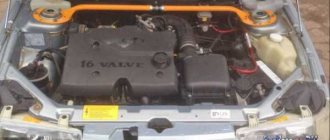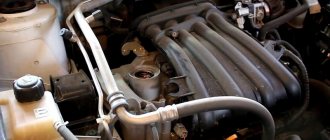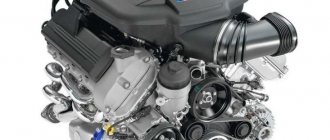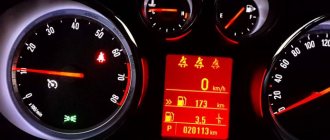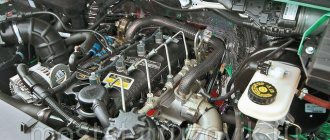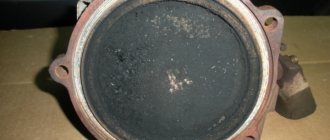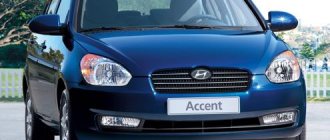What domestic cars are the most economical? The newest models of our automobile industry show lower fuel consumption rates than older models. In addition, each brand of car manufacturer has its own fuel consumption rate per 100 kilometers.
Units
Typically measured as:
- the amount of fuel consumed by a car when covering a given distance. Widely used in countries with the metric system, where consumption is measured in liters per 100 vehicle kilometers (l/100 km) [ source not specified 2448 days
]. The lower the value, the more economical the car; - the distance during which the car will consume a given amount of fuel. Widely used in countries with English units, where consumption is measured as the number of miles a car can travel on one gallon (UK or US) of fuel (miles per gallon (MPG))[ 2448 days
]. In India, Japan, and South Korea, efficiency is measured in km per liter of fuel. The higher the value, the more economical the car.
Conversion formula:
- liter/100 km = 282.48/gallon (Imperial gallon);
- liter/100 km = 235.21/gallon (US gallon).
Metric system/Distance over which a vehicle will consume a given amount of fuel (red curve - based on English gallons, blue curve - based on US gallons)
Is addiction less than everyone thinks?
Automakers are coming up with more and more new ways to force cars to be updated as often as possible, and this includes “games” with consumption. For example, it is already quite common to see three- or five-cylinder engines that are supplemented with turbines. As a result, 125 hp are “squeezed out” from 1 liter of working volume. – but it’s difficult to say how long such an engine can last.
On the other hand, there are examples where less volume means more consumption. For example, several engines were installed on the Oka, including the following:
- VAZ-11113 for 2 cylinders with a volume of 0.7 liters. With a power of 33 hp. the engine consumes 6.8 liters of gasoline per 100 km;
- TJ376QEI for 3 cylinders with a volume of 1 liter. With a power of 53 hp, this engine consumes only 5.5 liters per 100 km.
There is a more extreme example - the Mazda RX-7 with a rotary piston engine.
a volume of 1.3 liters shows a power of 255 hp. with a consumption of 13 liters per 100 km. True, for this type of engine the displacement is calculated according to special rules, but the owner ultimately saves on taxes (where they are calculated based on volume).
As for the Oka, half of a conventional four-cylinder engine will consume as much fuel as a whole engine, while having half the power. In principle, average measurements confirm this. According to calculations by the British company Emission Analytics, the actual fuel consumption of cars
with engines of different sizes like this:
- up to 1 liter – 7.3 liters per 100 km;
- from 1 to 2 liters – 6.1 liters per 100 km;
- from 2 to 3 liters – 6.3 liters per 100 km;
- from 3 to 4 liters – 8.1 liters per 100 km;
- from 4 to 5 liters – 11.8 liters per 100 km;
- over 5 liters – from 12 liters per 100 km.
Counting Features
| This section is missing references to information sources. Information must be verifiable, otherwise it may be questioned and deleted. You may edit this article to include links to authoritative sources. This mark was set on January 27, 2012 . |
Previously, the calculation of fuel consumption was determined during factory tests by professional drivers during road tests on special tracks, now at some car factories this method has been retained, but is used for selective control of fuel consumption of manufactured cars, the check is determined by in-plant specifications (technical conditions), and is usually not published .[ source not specified 2448 days
]. . With increasing market demands, a methodology for industrial standardized tests carried out on stands was developed. This technique eliminated any subjective influences and is characterized by high reproducibility of results.
The methodology for measuring fuel consumption and CO2 emissions is documented in Directives EC 715/2007 and EC 692/2008.
For more accurate calculations, special cycles are distinguished; a detailed description of the cycles is available in the above-mentioned Directives:
- “urban” cycle - characterized by a greater intensity of changes in vehicle speed, including the need to warm up, engine operation while parked at traffic lights and in traffic jams, as well as acceleration and sudden drops in speed to zero. As a result, increased fuel consumption;
- “suburban” cycle - characterized by a smoother ride and a consistently maintained speed close to cruising. Consequence: relatively low fuel consumption [ source not specified 2448 days
]; - “mixed” cycle is a kind of “golden mean”, that is, the calculation is carried out in conditions where both sharp “urban” and calm “suburban” driving styles are used. Moreover, it is not necessary that the “suburban” part of the cycle be carried out outside the city: the main thing is to maintain the driving style as during the “suburban” cycle.
During testing, the car is located in the testing laboratory, on a power stand - the wheels of the car spin the drums of the stand, the automation (formerly the test driver) clearly performs the acceleration-braking-uniform motion cycles. Flow analysis is carried out on the basis of exhaust gas analysis (in some modifications of the test, a hardware flow meter is inserted into the fuel line).
The headlights, generally all additional electrical loads, air conditioning, etc. are turned off, the car is fully operational and serviced, the tank is filled with standard fuel, there is no air resistance.
It should be noted that these are the data that are published, since they can be confirmed at any time on a test bench. These data allow us to objectively compare different cars, or cars of different modifications, etc. Having received the result from these tests that car “A” is 20% more economical than car “B,” we have the right to expect that in real operation the fuel consumption ratio "A" and "B" will be similar.
But with all this, the specified standards EC 715/2007 and EC 692/2008 (namely, they are indicated by car manufacturers) can in no way be standards for practical, operating consumption or fuel write-off for accounting purposes.
For the purpose of writing off fuel when operating vehicles in Russia, periodically reissued documents of the Ministry of Transport of the Russian Federation and/or other departmental acts are used (for example, for the military - the corresponding order of the Minister of Defense, etc.)
Eat less, weigh less
If you are in good health and plan to lose 5-7 kg on your own, use “crash diets”. The difference between them and therapeutic fasting is that with a “crash diet” you continue to eat regularly. But only with a strictly defined set of products. You can easily find recipes for such nutritional methods in numerous reference publications on improving the health of the body. An example of a “impact diet” is the so-called fragmented diet, which is particularly effective. It is based on the principle of separate consumption of foods of different categories, which allows the body to better absorb food.
- “Crash diet” option:
On Monday, give yourself a vegetable day, on Tuesday, a meat day, on Wednesday, an egg day, on Thursday, a dairy day, on Friday, a fish day, on Saturday, a fruit day, on Sunday, eat whatever you want. This way you can lose 5-7 kg in just three weeks.
There are several types of “crash diets”. They all differ slightly from each other and, as a rule, the calculation is based on either reducing the caloric content of food or reducing the consumption of liquid, fat and carbohydrates. Therefore, if you start this method of losing weight without consulting a doctor, follow the main rule: listen to your body’s reaction. Don't make yourself sick because you want to quickly lose weight.
If you experience dizziness and loss of appetite, then most likely the “crash diet” is not for you. Turn to more reliable and longer-lasting methods. Live by the motto: “Don’t get fat!” Lose weight slowly, count calories. Remember: the faster your body loses extra pounds, the easier it is to gain them back. Do not reduce the number of meals, eat more often, but in small portions. When the body is hungry, it releases toxins. Less sweets, canned food, salt and alcohol (a glass of wine is already 100 calories)! Drink juices in the morning and don't overeat at night. The period of highest activity of the digestive system is from 12 to 17 hours.
Factors affecting fuel consumption
| This section is missing references to information sources. Information must be verifiable, otherwise it may be questioned and deleted. You may edit this article to include links to authoritative sources. This mark was set on January 27, 2012 . |
Fuel consumption is influenced by many factors, including random ones. The main reasons for an undesirable increase in flow rate are as follows:
- First of all, the driving style of the car and the features of its operation; a modern car, equipped with a catalyst in the exhaust system, has a high-precision fuel dosage system, with feedback on the composition of the exhaust gases.
- aggressive driving style, high speed and sudden acceleration of the car, incorrect choice of driving mode (for example, driving in a non-optimal gear);
- Accordingly, malfunctions of the engine and its systems can make this dosage system ineffective and inaccurate, cause incomplete combustion of fuel, and also reduce the efficiency of the engine itself. But it should be noted that violations of the fuel dosing system are monitored by diagnostic tools built into the car, and if the parameters do not match, a malfunction signal is turned on (this is one of the requirements of environmental legislation);
- increased resistance to movement (transmission malfunctions, incorrect wheel alignment angles, low tire pressure, jammed brakes, vehicle load, air resistance);
The key to the lowest fuel costs will be the good technical condition of the car, the choice of the optimal driving mode, and the driver’s experience. [ source not specified 2584 days
] Other important factors:
- aerodynamics
- transmission ratios (the ratio of the number of teeth of the driven gear to the number of teeth of the drive gearbox or gearbox)
- Curb weight
Eat less, weigh less
If you are in good health and plan to lose 5-7 kg on your own, use “crash diets”. The difference between them and therapeutic fasting is that with a “crash diet” you continue to eat regularly. But only with a strictly defined set of products. You can easily find recipes for such nutritional methods in numerous reference publications on improving the health of the body. An example of a “impact diet” is the so-called fragmented diet, which is particularly effective. It is based on the principle of separate consumption of foods of different categories, which allows the body to better absorb food.
- “Crash diet” option:
On Monday, give yourself a vegetable day, on Tuesday, a meat day, on Wednesday, an egg day, on Thursday, a dairy day, on Friday, a fish day, on Saturday, a fruit day, on Sunday, eat whatever you want. This way you can lose 5-7 kg in just three weeks.
There are several types of “crash diets”. They all differ slightly from each other and, as a rule, the calculation is based on either reducing the caloric content of food or reducing the consumption of liquid, fat and carbohydrates. Therefore, if you start this method of losing weight without consulting a doctor, follow the main rule: listen to your body’s reaction. Don't make yourself sick because you want to quickly lose weight.
If you experience dizziness and loss of appetite, then most likely the “crash diet” is not for you. Turn to more reliable and longer-lasting methods. Live by the motto: “Don’t get fat!” Lose weight slowly, count calories. Remember: the faster your body loses extra pounds, the easier it is to gain them back. Do not reduce the number of meals, eat more often, but in small portions. When the body is hungry, it releases toxins. Less sweets, canned food, salt and alcohol (a glass of wine is already 100 calories)! Drink juices in the morning and don't overeat at night. The period of highest activity of the digestive system is from 12 to 17 hours.
Fuel consumption rationing
| This section is missing references to information sources. Information must be verifiable, otherwise it may be questioned and deleted. You may edit this article to include links to authoritative sources. This mark was set on January 27, 2012 . |
Transport organizations and companies set maximum permissible levels of fuel consumption when operating vehicles. In this case, a distinction is made between the basic level of consumption and the calculated standard level of consumption. The basic level of fuel consumption is determined for a vehicle using a standard methodology and establishes the rate of consumption under normal conditions of use. The calculated standard level of consumption takes into account the specific operating conditions of the vehicle, as well as other factors, in particular, repairs. At the same time, the standards do not include fuel costs for garage, technical and other household needs, which are established separately.
The following types of norms are common:
- consumption rate per 100 mileage;
- consumption rate per 100 ton-kilometers (takes into account additional fuel consumption when transporting cargo);
- consumption rate depending on the category of vehicle (passenger car, truck, bus, etc.);
- consumption rate depending on the type of engine (petrol, diesel, gas).
To correctly take into account all possible operating factors, correction factors are introduced.
Fuel consumption rates increase:
- when working in winter in the southern and northern regions of the country, as well as in the Far North;
- when working in mountainous areas, depending on the altitude;
- when working on roads with a complex layout (at least 501 turns per 100 km);
- when working in cities, depending on the population;
- when transporting large, dangerous, etc. cargo;
- when working on new cars or on cars after major repairs;
- when working in difficult road conditions (snow, floods, muddy roads, etc.);
- during training driving;
- when using air conditioning in the cabin;
- other conditions[1].
Differences between smoking and vaping
The principle of a “smoke break” in the vaping industry is somewhat different from classic tobacco smoking. If after smoking one cigarette a person will not smoke again in the near future, then vaping is in no way limited to this. You can soar until you lose your pulse or until all the liquid is gone. It is for this reason that it is not always possible to clearly monitor slurry costs. But, you can limit yourself within the filling. In other words, if you have a tank, you can set yourself a clear goal of not evaporating more than 2 full fills or, say, evaporating 2 fills into a drip in one “smoke break” and no more.
Another point is that average smokers always smoke the same cigarettes, which means the nicotine content does not change. In vaping, for example, the same liquid can contain 0, 1.5, 3, 4.5, 6 mg/ml and so on. The higher the strength of the liquid, the faster the steamer steams. In other words, a person will have to evaporate 2 times more liquid containing 3 mg/ml than liquid containing 6 milligrams. And this becomes a key point in calculating consumption.
Also, everything may depend on length of service. With skill and, so to speak, when using a certain “technique” of vaping, you can vape with the same vaping liquid 2-3 times faster. There is an interesting way of smoking that originated in the army and, oddly enough, it is called “smoking the army way.” In this very interesting establishment it is not always possible to get cigarettes, shag or anything else and, let’s say, a group of 5 people “passes around” one rolled-up cigarette. When a person takes a puff, he must hold the smoke within himself until it is his turn again. When they hand him a cigarette, he exhales and takes another drag. Thus, nicotine in its entirety is absorbed into the body and you get high much faster. As is already clear, this method also applies to vaping. You don’t have to play “army” with friends or acquaintances—you can play with yourself. After taking a puff, you simply hold your breath for a while and then exhale.
Specific fuel consumption
In the automotive world, specific fuel consumption is usually inversely proportional to the weight of the car. It is best to divide fuel consumption by weight. Let's say a Honda Dio with a curb weight of 60 kg consumes 2l/100 km, which turns out to be 33l/100 km per ton. At the same time, the 2TE116 diesel locomotive, consuming approximately 400 liters/100 km, is capable of towing a train with a total weight of 10 kilotons + 276 tons of its own weight. That is, 25,690 kg of weight per liter of fuel consumed. Avoiding such extremes, a few average examples will be given below.
| Brand, model | Curb/gross weight(KG) | Average consumption l/100 km | Specific consumption per ton of total weight | Power(L/C) |
| VW Tiguan | 1500/2100 | 6 | 3,5 | 175 |
| IVECO Trakker 4×8 | 12000/52000 | 40 | 0,8 | 500 |
| GAZelle-Next | 1900/3500 | 9,5 | 2,714 | 120 |
| Mercedes-Benz R172 | 1435/1885 | 10 | 5,3 | 204 |
| BelAZ-75710 | 360000/810000 | 1300 | 1,6 | 4664 |
What determines kilocalorie consumption?
The amount of energy consumed depends on many factors: age, gender, weight and height of a person. Calorie calculation is also influenced by climate, hormonal balance and a person’s lifestyle. The body spends the bulk of energy on basic metabolic reactions: cardiac activity, breathing, maintaining body temperature and metabolism, as well as on physical activity: sports and physical work. That’s why it’s so important to eat well during heavy workloads. Insufficient energy consumption forces the body to turn to reserves, when used up, weight loss occurs. Conversely, excess calories cause the formation of fat deposits. And where there are deposits, there is excess weight, self-doubt, and all kinds of diseases.
Even if you are planning to eat healthy, you need not only to choose a diet to suit your taste, but also to make a competent calculation of the calories you need. For this, there are special tables that accurately indicate the amount of fats, proteins and carbohydrates contained in one hundred grams of the product you have chosen. It is believed that adults who lead a sedentary lifestyle need approximately 40-50 kcal per 1 kilogram of weight. A man with daily heavy physical activity requires 70-100 kilocalories per 1 kilogram of weight. And for older people, according to doctors, only 30-35 kcal per 1 kg is enough. With children everything is different. Two thirds of all calories consumed are spent by the child's body on growth processes. Therefore, about 120-130 kilocalories are needed per kilogram of a child’s body weight. As you can see, the calculation is quite simple.
Article on the topic: Diet from Angelina Jolie: healthy eating every day
Fuel consumption monitoring
Graph demonstrating the fact of fuel theft
In connection with the massive theft of fuel in transport organizations and companies, the issue of control over its proper consumption is acute. To eliminate fuel waste, in addition to strict consumption regulation, technical control methods are widely used. For example, fuel level sensors are used to detect changes in the level in the tank or to measure the flow of fuel in the engine fuel line. They are often an integral part of vehicle monitoring systems that allow operators to remotely monitor both the location of vehicles and sensor readings. Modern high-precision fuel sensors allow achieving reading accuracy of up to +/- 1%, which far exceeds the accuracy of standard on-board systems.
Resistance while driving
To overcome rolling resistance and air resistance, a car needs a lot of energy. So, at an average constant speed of 100 km/h, a car needs a power of 14 kilowatts. To generate this power, an average of 1.5 liters of fuel per hour is required.
See also: Causes of increased fuel consumption
In fact, fuel consumption at a speed of 100 km/h will be higher, since internal combustion engines lose too much energy during fuel combustion. That is, in fact, part of the energy simply does not reach the conversion of chemical energy into mechanical energy. So, when a car is moving along a highway at a speed of 100 km/h, when fuel is burned, only 31 percent of the energy obtained from fuel combustion remains to maintain speed.
19 percent of the energy is spent on overcoming the friction of the internal components of the engine, the charge cycle and the fuel combustion process.
Another 19 percent of the energy obtained from fuel is consumed by the transmission, drive shafts, wheel bearings, tires and power steering.
About 8 percent of fuel energy is wasted running air conditioning and other electrical systems.
To overcome external resistance associated, for example, with the weight of the machine, another 12 percent of energy is needed. Overcoming air resistance during acceleration requires another 11 percent of the energy obtained from the fuel.
Fuel consumption accounting
Modern car manufacturers recommend keeping written records of fuel consumption. To control fuel consumption, you can keep a logbook. It's not difficult, but it will certainly bring benefits. This way, you can promptly identify any changes (both positive and negative) and take appropriate action. In the event of a significant increase in fuel consumption, you should think about how, where and under what circumstances the vehicle was used during this sub-optimal consumption[2].
Automated calculation
To facilitate computational operations, an online calculator .
The device allows:
- calculate actual fuel consumption per 100 kilometers;
- determine its cost (taking into account travel expenses).
Device operation technology:
- turn on the calculator,
- A menu with windows will open on the display: Mileage (km), Fuel consumption (l), Fuel price (RUB), Your car (model)
- enter the required data,
- press the “Calculate” button.
In a few seconds the results will appear in front of you.
